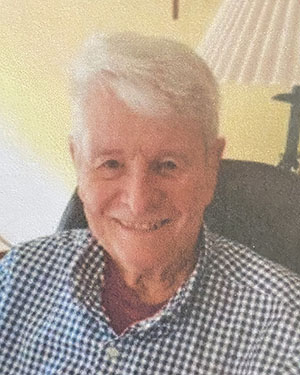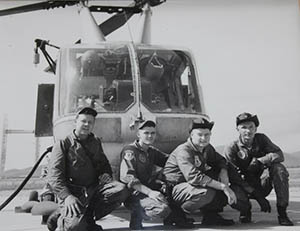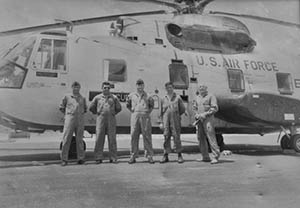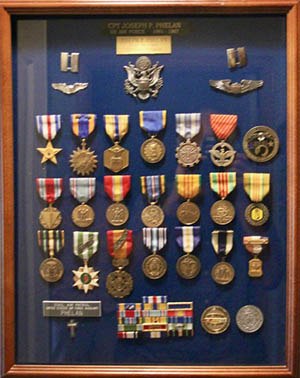Air Force Vietnam War McHenry, IL Flight date: 10/18/23
By David Adams, Honor Flight Chicago Veteran Interview Volunteer
1965: The Vietnam War was heating up. President Johnson ordered an intensive bombing campaign against North Vietnam called Rolling Thunder. Hundreds of fighter jets and supporting airplanes swarmed deep into hostile territory. On March 2, 1965, Joseph P. (“Joe”) Phelan flew his rescue helicopter to pick up a downed fighter pilot in North Vietnam. By doing so he participated in the first air rescue in the North. Joe was awarded the Silver Star for his gallantry and devotion to duty.
Joe was born in Port Chester, NY and grew up in Armonk “just 33 miles from Yankee Stadium”, he reports. Joe graduated from Archbishop Stepinac High School, White Plains in 1956. He chose to attend St. Michael’s College, Colchester, VT. While having his eye on an eventual medical career, Joe took advantage of its AFROTC program. Graduating in 1960 with a Bachelor of Arts in biochemistry and an USAF commission, he was ready for anything.
Newly-minted Second Lieutenant Phelan was headed for Undergraduate Pilot Training (UPT) at Craig Air Force Base, Selma, AL. Joe’s entry into active duty was deferred approximately eight months during which time he had a variety of civilian jobs. Eventually he would report to UPT on March 10, 1961 becoming a student in Class 62F. He remembers his class was the first UPT class to train exclusively in jets. First came the primary trainer Cessna T-37 “Tweet” and next the advanced trainer Lockheed T-33 “Shooting Star”. Joe especially enjoyed formation flying. Close to graduation in March 1962, his class of about 35 received a list of airplanes from which they could select one for operational flying. As usual, according to Joe, nearly everyone wanted a fighter. However, with only one fighter assignment, which went to the number one student, the remainder would choose from multi-engine transports or helicopters. Stating that he was “a risk taker” he chose helicopters. Many downed pilots in Vietnam thank him for his decision.
Joe’s helicopter training course was conducted at Stead AFB, NV, close to Reno. But before jumping into a helicopter he had to complete the USAF survival school course given at Stead. The three-week curriculum included escape and evasion from an “enemy force”, travel over mountainous terrain while evading the enemy, internment in a simulated prison camp with intensive interrogation and sensory deprivation, and indoctrination in basic survival skills. Joe especially remembers the nighttime live-fire exercise with his crawling under barbed wire while tracers arched overhead.
His first helicopter flight was memorable. After he climbed in, his instructor flew the helicopter around the base, put it into a “hover”, and turned the controls over to Joe. He grabbed the cyclic control and immediately the helicopter began swaying back and forth. The instructor said, “all you jet pilots are alike, overcontrolling the helicopter”. Over the next five months Joe became competent to fly the Sikorsky H-19 Chickasaw, Piasecki H-21 Workhorse/Shawnee (also known as “the flying banana”), and Kaman HH-43 “Huskie”, his first operational helicopter.
Graduating in November 1962 as a full-fledged helicopter pilot he received an assignment to an Eastern Air Rescue unit at Shaw AFB, Sumpter, SC. There he honed his skills flying the Huskie. Later that year his detachment was sent TDY to Key West NAS, FL in response to the Cuban Missile Crisis. The mission was to be ready to rescue anyone needing help on land, sea or air.
Joe recalls that by 1964 the air war in Vietnam was intensifying, airplanes and aircrews were being shot down and men lost. So his unit was instructed to form a stand-alone rescue unit to be sent to Vietnam. More training ensued: jungle survival in Panama and water survival off the coast of South Carolina. The final stage was combat flight training conducted at Stead. Joe recalls that all of this specific training and organization was relatively new to the Air Force. Training was complete by October 1964 when they received an assignment to Da Nang AFB, South Vietnam.




Joe and his fellow pilots, crew chiefs and pararescuemen “PJs” flew the circuitous air route from Travis AFB, CA, to an air base in Japan, to Clark AB, Philippines, and finally to Da Nang. Because of a several day delay at Clark, he reports that he found the base surroundings pleasant, especially the golf course! Arriving at Da Nang he discovered their three HH-34s required assembly which was quickly accomplished. His unit became Detachment 5, Pacific Air Rescue Center, or just “Det 5”. They arrived in Southeast Asia during the monsoon season. Ensuing flooding found Det 5 flying civilian support sorties for about six weeks into early 1965. Joe’s principal mission however was search and rescue of downed pilots including Army, Navy, Air Force, and South Vietnamese. Being the first air rescue unit in-country, Joe and his colleagues “wrote the book” on air rescue. A typical sortie began with two Huskies in the early morning hours flying north from Da Nang to preposition close to the DMZ at Quang Tri. From this staging area Joe states that fighter strike radio frequencies were monitored for requests for assistance. He recalls that with the beginning of the Rolling Thunder operation the urgent necessity of Det 5’s search came into focus.
Joe remembers that “our Huskies had a sheet of titanium over the bottom of the A/C, as well as a partial panel on the pilots and copilot side doors. We were told it would deflect bullets depending on the angle it hit. Not good enough to stop 50 caliber. At times we used an extended range fuel tank, but we found it at times took up too much room.” Asked if the Huskies were camouflaged, he remarks, “just shiny metal. One time we found ‘Snail assing along’ painted on the side of our A/C. We thought the Aussies special forces out of Quang Tri had paid us a compliment. We wanted to leave it, but our commander had us wash it off.”
Joe remembers vividly two distinct search and rescue sorties during Rolling Thunder. The first occurred on the Operation’s first day, March 2, 1965. Joe and his crew, call sign Bandy 95, teamed with another Huskie, Bandy 96, to fly toward North Vietnam, thus airborne and ready for any rescue. First, the two flew east over the South China Sea then north over North Vietnamese waters, the Gulf of Tonkin. While still over the water, they were directed to a downed pilot who had bailed out of his A-1H Skyraider. Joe located the Vietnamese Air Force pilot in his life raft about eight to ten miles from shore. After the pilot “popped smoke” Joe put his PJ, Sgt Jon Young, into the water. The pilot had suffered significant burns and was only too happy to be rescued. Once the Skyraider pilot was onboard and safe Joe was directed into North Vietnam to search for a downed F-100 Super Sabre pilot. At treetop level Joe penetrated the North and located the general area of the pilot. Acting as “low bird” Joe lowered his PJ to the ground to search in the almost impenetrable elephant grass. Bandy 96 remained above as “high bird”. PJ Young could not locate the pilot although he did recover his helmet with “Lt. James Lockhart” stenciled on it. During this his search and recovery attempt Joe took heavy small arms and antiaircraft artillery fire. One round damaged a rotor blade causing handling problems. However, he persisted, flying high cover for Bandy 96 while it searched and found another downed pilot. Joe’s efforts earned him the Silver Star. The citation to accompany this decoration reads in pertinent part as follows:
“On [2 March 1965], Lieutenant Phelan, acting as a Rescue Crew Commander of an HH-43F helicopter, flew rescue missions totaling two and one half hours over unfriendly territory in search of two downed American pilots. During this critical operation, his helicopter encountered continuous antiaircraft and small arms fire. After the successful rescue of one pilot, Lieutenant Phelan made an approach to another parachute which had been sighted. While hovering over this area in search of the downed pilot, extremely accurate ground fire was encountered and a hit was sustained in one of the rotor blades, and Lieutenant Phelan was forced to withdraw. With complete disregard for his own personal safety, Lieutenant Phelan flew cover for a second helicopter crew while they rescued an additional pilot.”
Incidentally, Lt. Lockhart, whom his crew failed to locate, managed to evade capture for several days, was taken prisoner, and transported to the Hanoi Hilton where he spent the next eight years of his life. Lockhart, was the first USAF Pilot to be shot down and captured during the Vietnam War. Joe only discovered his fate after Lockhart’s release and repatriation during Operation Homecoming on February 12, 1973.
Joe’s second Rolling Thunder operation rescue happened about three weeks later on March 26. He describes this successful rescue of a Navy pilot as “classic”. He and his crew were conducting a training mission just off the coast near Da Nang. On Guard channel he heard a F-8 Crusader two-ship returning from a bombing sortie into North Vietnam. One F-8 received significant damage so as to preclude it from landing back on the Navy carrier from which it had been launched. Joe monitored the radio and when the pilot ejected his Huskie was close to the pickup location about 20 miles north of Da Nang. Arriving overhead his crew saw the pilot in his life raft. Joe’s PJ got him up into the helicopter. Piece of cake!
Joe credits his success on these two rescue missions as “being in the right place at the right time and be able to do the right thing”. He recalls that Det 5’s moto was “fly scared” which should be taken to mean “don’t become complacent”. For example, when airplanes were landing back at Da Nang following a night sortie, Viet Cong soldiers located at the end of the runway, fired on fixed wing and helicopters alike. On one such night landing Joe remembers not seeing the stream of tracers following his blacked-out helicopter until a ground crew member told him. Nevertheless, Joe took frequent accurate ground fire resulting in holes in his helicopter but none prevented him from successfully completing 285 combat sorties.
Joe emphasizes, though, that not every sortie was life-threatening. During his tour, his unit was asked to fly General William Westmoreland and his wife on an aerial tour from Da Nang north toward the DMZ. Joe flew his wife and another crew, the General. Two Huey gunships escorted the Huskies. No problem!
Following his tour in Vietnam, he spent another two years with Detachment 5 of Eastern Air Rescue at Patrick AFB, FL where he transitioned to the HH-3 “Jolly Green” rescue helicopter. The Detachment’s mission was to support the Gemini/Apollo space missions. During this last assignment he and his Jolly Green crew performed the longest over-water helicopter mission to date. The British Government had requested the removal of a communication tower on Antigua deemed a danger to aviation. No problem for Joe. Teamed with a C-103 flying overhead in support, the mission was accomplished when the antenna reached Coco Beach, FL.
Finally, in order to promote support and understanding of US efforts in Vietnam, Joe appeared on many TV and Radio outlets to include the Ed Sullivan Show, the Today Show, Walter Cronkite Show, and others. He remembers interviews by Cronkite, Sullivan, Hugh Downs, and Bob Hope.
His decorations and ribbons include the Silver Star, Air Medal with ten oak leaf clusters, Air Force Commendation Medal, Presidential Unit Citation, National Defense Service Medal, Small Arms Expert Marksmanship Ribbon, Air Force Longevity Service Award, Armed Forces Expeditionary Medal–Vietnam.
Having fulfilled his USAF obligation Joe resigned his regular commission and received an honorable discharge as a Captain on January 10, 1967. Prior to leaving the service he networked with colleagues, seeking a job with a company where he could use his college education and leadership skills obtained in the Air Force. He settled on a position with Dow Chemical, headquartered in Midland, MI. At first concentrating on sales, Joe served Dow for the next 26 years in several of its offices including those in Detroit, Chicago, and Midland. He fulfilled such key positions as regional sales manager and product development manager. He and his wife Jan had adopted a plan for him to retire at 55 and enter the lay pastoral ministry of the Catholic Church. Retiring from Dow in 1993, Joe obtained a Master’s Degree from Loyola in religious studies and ministry. He was ordained a Catholic Church Deacon. After fulfilling those religious responsibilities in a variety of settings, he was asked in 2004 to join Northwestern Memorial Hospital in McHenry as its Chaplain. Joe faithfully served as Chaplain until his last, and final, retirement in 2016.
Joe and Jan, who married during Joe’s pilot training assignment, recently celebrated their 62nd wedding anniversary. They revel in their four children, 12 grandchildren, and 11 great grandchildren.
Reflecting on his service Joe says, “My overall experience in the USAF was extremely positive, rewarding and character building. While in the USAF I truly believe I served with the best of the best!!! Air Rescue’s motto was and is ‘These things we do that others may Live’ and we lived by those words.”
Joe, you have more than earned your Honor Flight Chicago flight.


